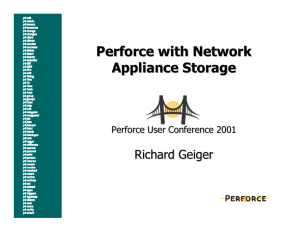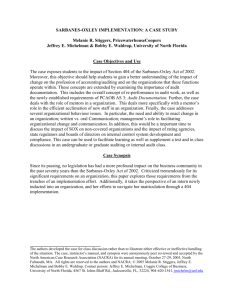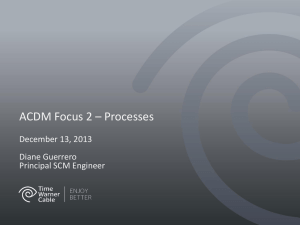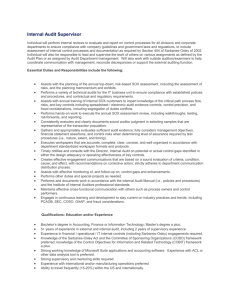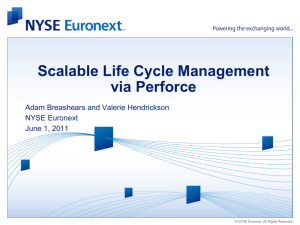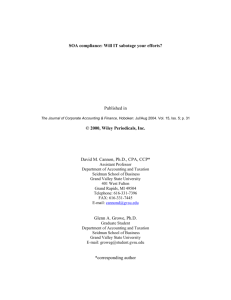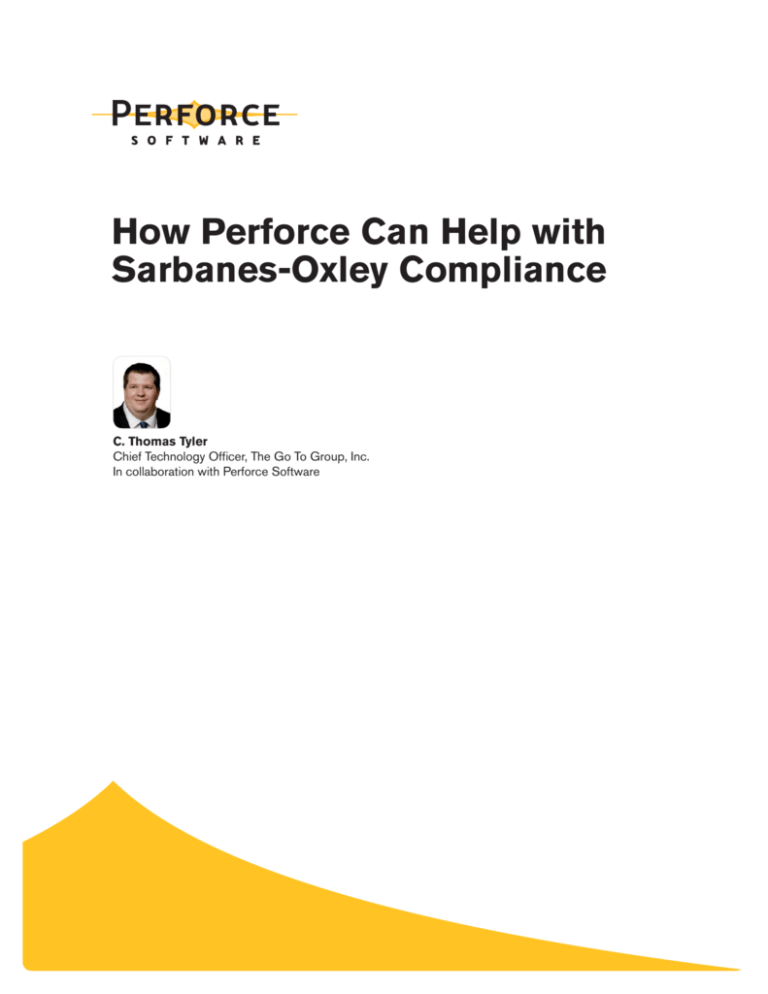
How Perforce Can Help with
Sarbanes-Oxley Compliance
C. Thomas Tyler
Chief Technology Officer, The Go To Group, Inc.
In collaboration with Perforce Software
Perforce and Sarbanes-Oxley
The Sarbanes-Oxley Act requires accountability in the management of systems that affect
financial reporting. Perforce delivers key features necessary to comply with the law, such
as access control, strong accountability, and policy enforcement tools. Better still, Perforce
provides an efficient infrastructure for an automation-based approach to compliance that
yields enhanced productivity—a nice side benefit.
Sarbanes-Oxley in a Nutshell
The Sarbanes-Oxley Act of 2002 is
legislation aimed at improving investor
confidence in the American financial trading
system. The Act promotes new standards
for financial reporting for public companies,
and sets up a policing mechanism to ensure
those standards are adhered to.
02
The big news for information technology is
Section 404 of the Act, titled “Management
Assessment Of Internal Controls.” Section
404 effectively expands the scope of
financial report auditing to include internal
controls. Among other things, that involves
IT systems and processes that produce
financial reports. The Act requires that
management of public companies attest
to the effectiveness of those systems, and
that registered public accounting firms
audit the internal controls, then append
their own independent assessments of the
effectiveness of those controls.
To form an opinion about the effectiveness
of IT systems, financial reporting auditors
are more technically savvy about the
management and operation of IT systems
than ever before. They’re asking tough
questions: How can changes made to your
financial reporting software be audited?
What Software Configuration Management
systems are in place, and are they used for
How Perforce Can Help with Sarbanes-Oxley Compliance
all systems that significantly affect financial
reports? What access controls are in place
to prevent unauthorized personnel from
modifying financial reporting systems? What
is your change management workflow?
For those in the software development
world who have been involved in efforts to
improve the software development process,
these are familiar questions. SarbanesOxley simply forces public companies to
answer them, at least with regard to those
systems contributing significantly to financial
reporting.
What You Need to Know About
Sarbanes-Oxley Compliance
If you work for a public company, you need
to know that following established best
practices for development and maintenance
of certain software systems—those that can
significantly impact financial reporting—is
now required by law. Audits of financial
reports go far deeper than just reviewing the
financial reports. They go into the heart of IT
systems that produce those reports.
The law makes it clear that corporate
executives are responsible for attesting to
the quality of the controls that produce their
financial reports, and that statements they
make must be auditable. Further, auditors
from public accounting firms are responsible
for making their own independent
assessments of the effectiveness of the
company’s controls.
did occur, the standards used to evaluate
a company’s systems weren’t consistent.
With Sarbanes-Oxley, the efforts of public
auditing firms are now coordinated by the
How do auditors determine what’s effective?
Public Company Accounting Oversight
It turns out they have some good ideas
Board, or PCAOB (http://www.pcaob.org),
about how to ensure that IT systems are
which was charted by the law. The PCAOB
managed effectively, because best practices
is responsible for establishing and adopting
have been established, have evolved, and
standards used for auditing internal
have matured within
controls of public
the software world for
companies. The Board
Established disciplines such as
decades.
ensures that internal
controls of all public
configuration management and
Established disciplines
companies are audited
such as configuration
against a common set
change management have evolved to
management and
of standards.
change management
help answer the questions auditors
have evolved to help
What are the
answer the questions
auditors looking for
love to ask, such as “Who changed
auditors love to ask,
from CIOs and IT
such as “Who changed
managers? They’re
what?”, “When did they do it?”,
what?”, “When did they
looking to make
do it?”, and “Why?”
sure that systems
“Who approved the change?”, and
With Sarbanes-Oxley,
used to produce
you can’t get away
financial reports
“Why?” With Sarbanes-Oxley, you
with answering those
follow industry best
questions just once
practices. Although
can’t get away with answering those
during the audit.
the law doesn’t
explicitly define best
questions just once during the audit.
You have to show how
practices, in practice
the systems you have
auditors rely on
in place can answer
established standards
those questions at any
for measuring the
time. This is reinforced by Section 409 of
maturity of various processes. For example,
the Sarbanes-Oxley Act, titled “Real Time
if your organization has been “climbing
Issuer Disclosures.” Thus, there’s a natural
the SEI scale,” 1 or working toward ISO
tendency for auditors to favor solutions
9001 certification, you’ll be able to answer
involving extensive automation.
some of the auditors’ initial questions
quickly. Auditors consider a wide range of
Prior to Sarbanes-Oxley, audits focused
factors, such as the ability of your process
primarily on the resulting financial reports,
to provide basic quality assurance, and the
and rarely on internal controls surrounding
ability of your systems to assure that only
the systems companies used to generate
authorized personnel have access, to name
those reports. When audits of systems
a few things.
The “SEI scale” is an informal reference to the Software Engineering Institute’s Capability Maturity Model.
1.
03
Prominent features that make Perforce
particularly well suited to SarbanesOxley compliance efforts
04
• Configuration management.
• Software Development Life Cycle (SDLC)
support, including support for clear handoffs and promotions. Promotions can involve
anything represented as a file: source code;
documents; and runtime environment files
such as libraries, executables, images, and
even large files such as CD images.
• Access controls and the ability to assign
promotion authority to groups of authorized
users.
• Audit trails for various activities.
• Ability to rollback changes.
• Change management for runtime
environments.
• Document management and document
promotion.
• Change review notification.
• Policy enforcement triggers.
• Integrated enhancement, bug, and issue
tracking.
• Workflow process management support.
For example, take Configuration
Management (CM) as a sample discipline.
Within the software development world,
CM (sometimes called SCM, for Software
Configuration Management) is considered
the foundation of any organized software
development process. When you attempt
to achieve any measure of quality for
a software development process, CM
infrastructure must be in place, just as
surely as the computer network. For
example, to climb only to Maturity Level
2 on the Software Engineering Institute’s
How Perforce Can Help with Sarbanes-Oxley Compliance
capability level scale, CM is one of the key
process areas that your organization needs
to establish. When auditors are seeking
to determine the effectiveness of internal
controls, their job, and your audit, will go a
lot easier if you can show that you have the
basics, such as CM, under control.
One word of caution: be wary of scope
creep in your efforts to comply with
Sarbanes-Oxley. The reality of modern
public companies is that everyone depends
extensively on IT to support financial
reporting. The intent of Sarbanes-Oxley
is to ensure that the IT systems used for
financial reporting have effective controls
that are designed and operated in such a
way that they’re reliable. The focus is on just
those IT systems that can materially affect
your financial reporting. Sarbanes-Oxley
audits typically start with an assessment of
just which systems and controls should be
audited. The scope of a Sarbanes-Oxley
audit is limited with regards to IT: it doesn’t
apply to your products or services, which
can also rely extensively on IT. For reasons
of efficiency, you might want all such
systems to follow best practices, but that’s
going above and beyond what’s required for
Sarbanes-Oxley.
Ways Perforce Helps with Compliance
Yes, Perforce can indeed help with
compliance. In practice, SarbanesOxley compliance projects often involve
automation of internal controls. To that end,
Perforce takes you much farther down the
road to Sarbanes-Oxley compliance than
traditional SCM systems. Perforce provides
strong mechanisms to ensure compliance
with established policies. Perforce’s
extremely efficient and robust architecture
allows you to use it to manage much more
than source code, extending the ability to
05
Figure 1: Perforce managing runtime environments
1. The Development Release Area is a “no humans allowed” area, populated by automated build processes. Several
builds are shown deposited here.
2. Selected builds were promoted to the QA Release Area.
3. Software from the QA Release Area was deployed to a runtime environment on the QAWWW301 machine.
4. The QA’d software was later deployed to Production runtime servers: Web105, Web106, and Web109.
5. You can see the details of when and where changes occurred. You can use Perforce policy enforcement
mechanisms to ensure certain information is provided to allow a promotion, such as QA Signoff or an authorization ID.
support Sarbanes-Oxley objectives. And
Perforce’s powerful visualization tools can
allow you to verify, for example, that software
in Production first went to a QA environment.
06
whodunit-type questions applies not just to
the source code, but to actual updates to
runtime environments, such as Production
or QA. For example, Perforce can answer
questions such as, “Who made updates
Sarbanes-Oxley audits go broadly and
to our Production systems today, who
deeply into IT systems involved in financial
authorized them, and when did they occur?”
reporting—you need
Figure 1 illustrates selected
to do more than simply
builds being promoted to new
mark off a checkbox
Perhaps the best thing about
codelines. Note the details of
indicating that you have
when and where the changes
a CM system in place.
using Perforce to support your
occurred, as well as who
Auditors take a “big
made the changes and who
picture” view, and they’re
Sarbanes-Oxley compliance
authorized them.
responsible for making
judgments about the
efforts is that the value added
SCM systems generally
overall effectiveness
provide good accountability
of your processes. A
by using Perforce translates into
and audit trails, but their
truly modern software
use has traditionally been
production line that takes
a return on investment.
relegated to source code
advantage of Perforce’s
control. Perforce is typically
extensive functionality
used for much more, due to
goes a long way toward giving auditors
its efficiency at managing and incrementally
the impression that you have everything in
distributing files. By extending its scope of
order—and that makes them less likely to feel
control, Perforce becomes the heart of a
the need to dig deeply and look for holes.
runtime-environment management system,
extending its strong controls and auditing
Perforce is an advanced SCM system, and
capabilities far beyond the realm of source
provides a comprehensive foundation for a
code.
modern software production line. A Perforcebased software production line takes
Perforce also provides document
advantage of many aspects of Perforce’s
management functionality. Various
functionality that help support Sarbanesdocuments, such as standards, policies,
Oxley objectives.
and procedures manuals that affect financial
reporting systems of a public company are
Because Perforce is particularly efficient
within the scope of an internal controls
at distribution of vast numbers of text
audit. Perforce can provide a clear workflow
and binary files, it’s often used not only
for documents, segregating “in work” or
to manage source code, but also to
“proposed” policy documents, for example,
handle distribution of files to live, runtime
from “approved” documents. Using Perforce
environments. The benefits of using an
to manage documents provides a clear audit
SCM system in this role are particularly
trail for documents as they move through
apparent in light of Sarbanes-Oxley
that life cycle, and also provides whodunit
compliance, because the ability to answer
information for those documents.
How Perforce Can Help with Sarbanes-Oxley Compliance
One interesting, often unexpected benefit of
Sarbanes-Oxley compliance projects is the
way they lead to enhanced communication,
especially within larger organizations. For
example, during this author’s experience
with Sarbanes-Oxley compliance projects,
the first sign that an audit was in progress
was a series of requests for Perforce
licenses from business units that had never
had a reason to interact previously.
Until that point, Perforce had been
associated primarily with the software
development business unit within the
organization. It became clear that other
business units had CM needs as well. What
followed was a wider appreciation of the
benefits of Perforce within the enterprise,
as more and more systems were put into
Perforce, some driven by Sarbanes-Oxley
compliance, others after they learned of
the process benefits of doing so, such as
process automation and rollback support.
Technical experts from across organizational
boundaries collaborated on compliance
projects. The job got done, and the new
relationships resulted in collateral benefit for
the organization as a whole.
Perhaps the best thing about using
Perforce to support your Sarbanes-Oxley
compliance efforts is that the value added
by using Perforce translates into a return
on investment. Sarbanes-Oxley–driven
compliance projects have yielded
unexpected benefits in terms of increased
efficiency through automation using
Perforce. As mentioned earlier, auditors
tend to favor internal controls that feature
extensive automation, and Perforce is all
about providing a foundation for a highly
efficient automated software production line.
07
www.perforce.com
North America
Perforce Software Inc.
2320 Blanding Ave
Alameda, CA 94501
USA
Phone: +1 510.864.7400
info@perforce.com
Europe
Perforce Software UK Ltd.
West Forest Gate
Wellington Road
Wokingham
Berkshire RG40 2AQ
UK
Phone: +44 (0) 845 345 0116
uk@perforce.com
Copyright © 2006 Perforce Software Inc. All rights reserved.
Australia
Perforce Software Pty. Ltd.
Level 10, 100 Walker Street
North Sydney
NSW 2060
AUSTRALIA
Phone: +61 (0)2 8912-4600
au@perforce.com


